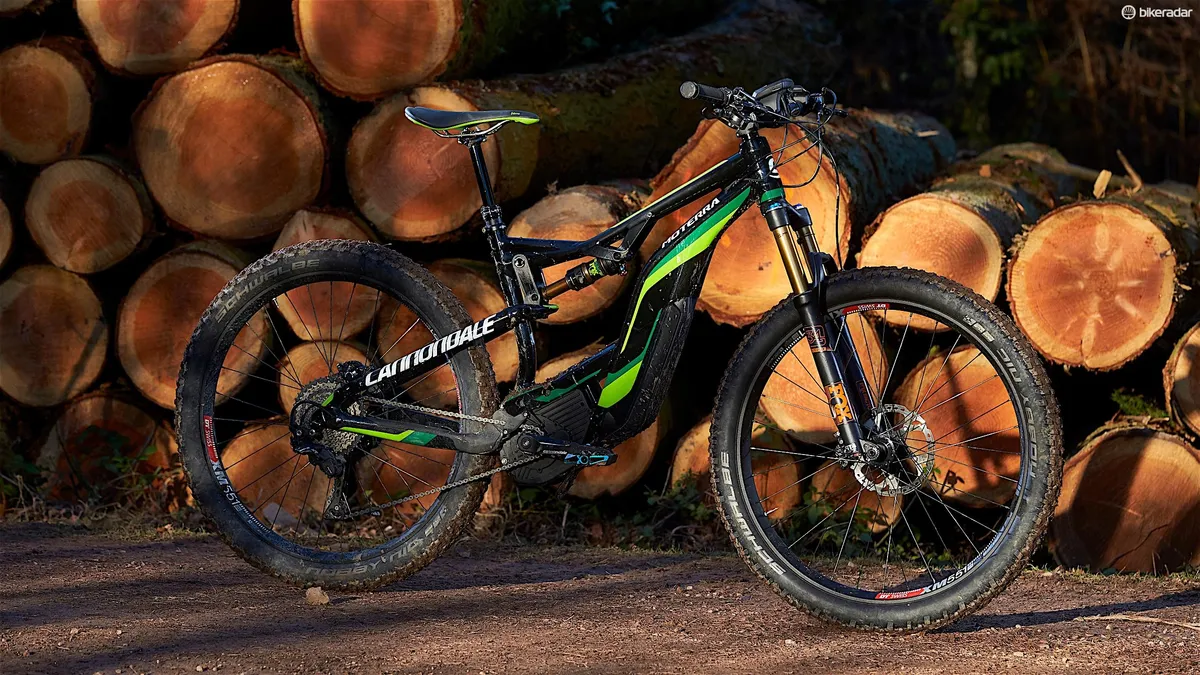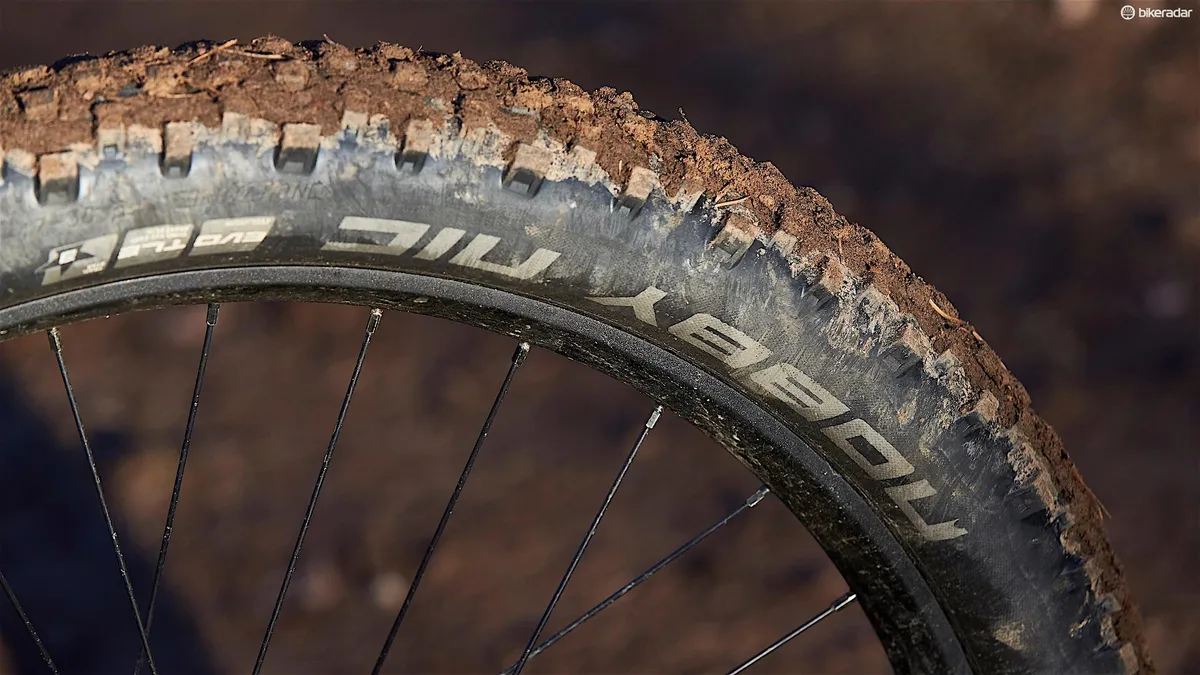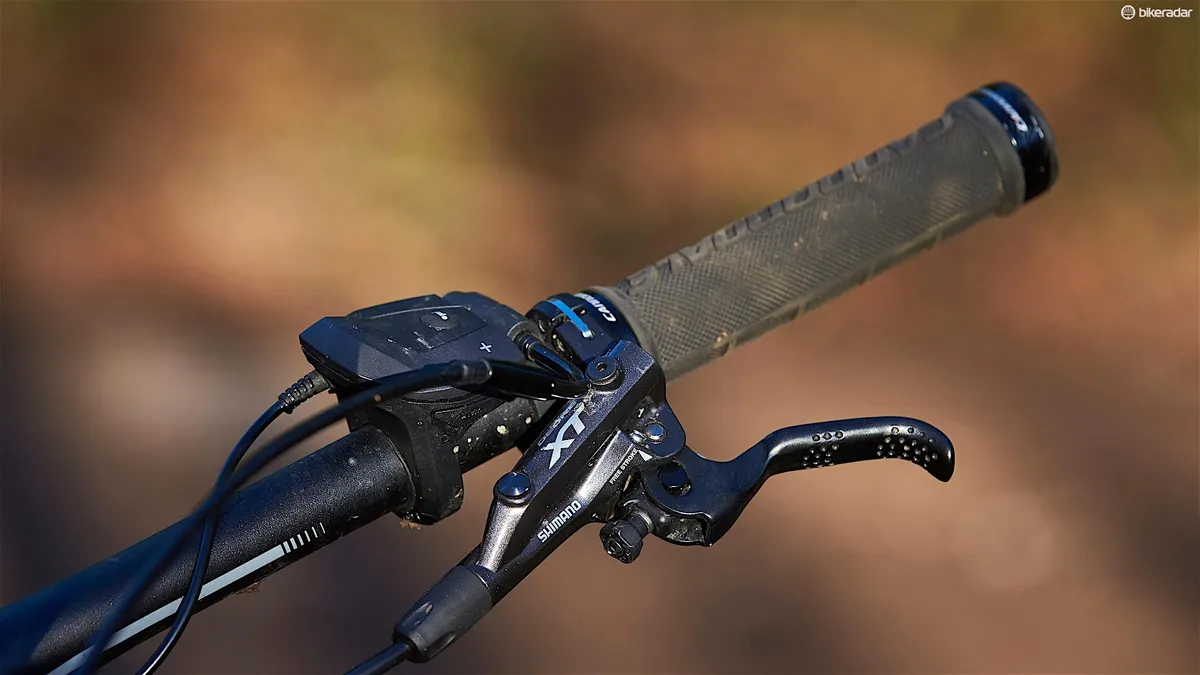With more brands ploughing cash into e-MTBs, we’re seeing some drastic leaps forward in terms of battery and motor integration. Cannondale is known for its innovative approach to bike design — remember the Fulcrum DH bike in the late nineties — and it has applied this to its latest range of Moterra e-MTBs.
The Moterra line-up offers a shorter travel AM version or a bigger hitting LT (long travel) option. We hit the hills on the top of the line AM model, the Moterra 1, to see just how it fares on the trail.
Cannondale Moterra 1 spec overview
- Frame: SmartForm C1 Alloy, with 130mm (5.1in) of travel
- Fork: Fox Factory 34 Float FIT4 E-Bike Optimised, with 130mm travel
- Shock: Fox Factory DPS EVOL
- Drive unit: Bosch Performance CX 250w
- Battery: Bosch PowerPack 500wh
- Drivetrain: Cannondale EC3 crank with custom Ai chainring, Shimano XT 11-speed mech, shifter and 11-42t cassette
- Wheelset: DT Swiss XM551 rims on Formula hubs with Schwalbe Nobby Nic SnakeSkin 2.8in tyres
- Brakes: Shimano XT (180mm rotors)
- Bar/stem: Cannondale C2 alloy 780mm/Cannondale C3 55mm
- Seatpost/saddle: KS LEV Integra 125mm drop/Fabric Scoop Elite
- Weight: 23.15kg (51lb) without pedals
- Head angle: 68 degrees
- Seat angle: 74 degrees
- Reach: 425mm (medium)
- Effective top tube: 612mm (medium)
- Chainstay length: 457mm
Cannondale Moterra 1 design
Access to the battery is via the underside of the downtube where it locks into the frame in the traditional manner
Cannondale has always preferred to do things very much its own way and when it comes to e-MTBs, nothing has changed. The bikes in the new Moterra range certainly got people’s attention when they were displayed at Eurobike. Why? Well, for starters the bike's silhouette is quite different to many of the bikes already out there, thanks to a big shift in battery placement — a bit like we saw on the carbon framed Lapierre also launched in 2016. A feat that isn’t exactly straight forward, but why go to all this trouble?
Cannondale was keen on going down the “full integration route”, according to Ash Clark, Cannondale’s product manager. While the motor has to be in a certain place (the bottom bracket area), the “battery can effectively be anywhere. Cannondale wanted to get the best balanced bike on the market, so centre of gravity was really key,” says Clark.
Cannondale worked out where it wanted the Bosch 500wh battery to be, then built the frame around it. The structure created to house the battery was dubbed the ‘Torsion Box’, which is essentially a chamber where the battery sits and is welded to a heavily hydroformed downtube. This structure, according to Cannondale, also helps improve overall stiffness, which is pretty important when you consider the weight of the bike and the forces being applied to the chassis.
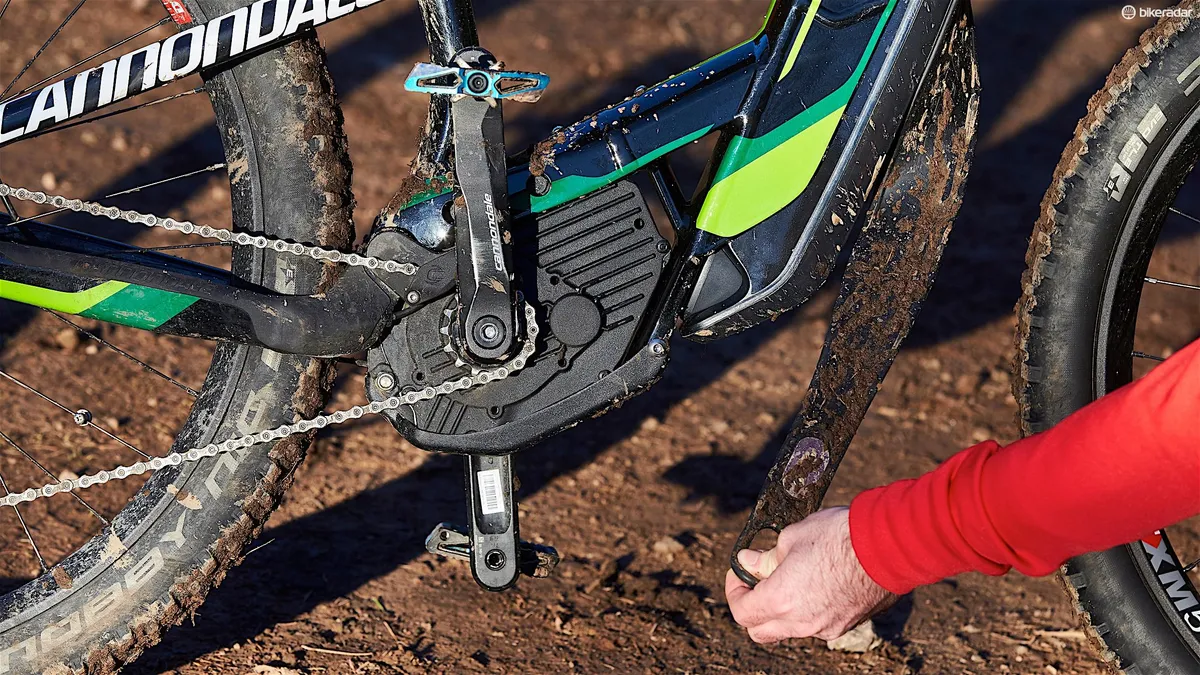
Access to the battery is via the underside of the downtube where it locks into the frame in the traditional manner, but to prevent that irritating rattle that some e-MTBs can suffer from, Cannondale’s added its ‘BatStrap’ — a thick rubber band that’s almost as wide as the battery and which is pulled and hooked tightly into place down near the bottom bracket. This not only helps to keep the battery secure, it also offers some additional protection. On top of that, there’s a skid plate should you sump the bike out in properly undulating terrain.
Cannondale Moterra 1 frame and equipment
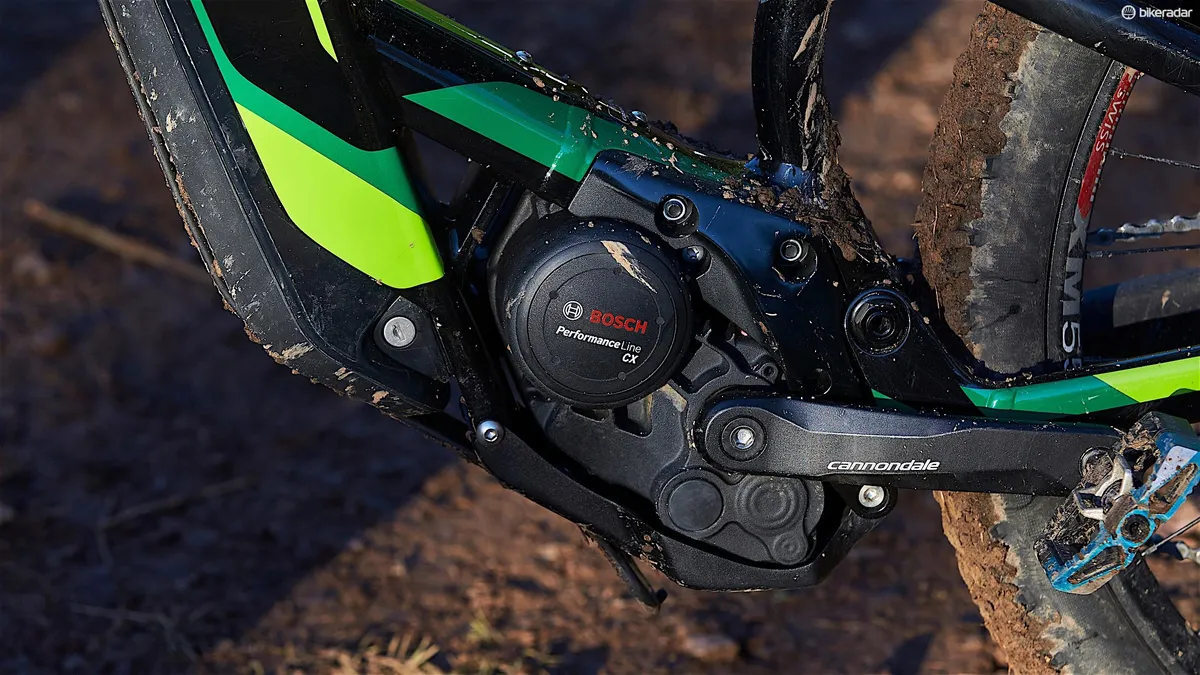
Aside from Cannondale’s different take on battery placement it has also mounted the motor slightly differently. Its proprietary Si motor mount angles the Bosch Performance CX 250w unit to both align the bike's main pivot with the chain line, in a bid to improve suspension performance, as well as allow the Moterra to sport much shorter chainstays than we’re used to seeing in this category of bike. The 130mm travel AM bike has to accommodate a plus sized 2.8in tyre and has a 457mm chainstay (that’s nearly 20mm shorter than the new Lapierre Overvolt AM with the same Bosch motor), but impressively the 160mm travel LT version that comes shod with regular 2.35in tyres boasts even shorter chainstays at 443mm.
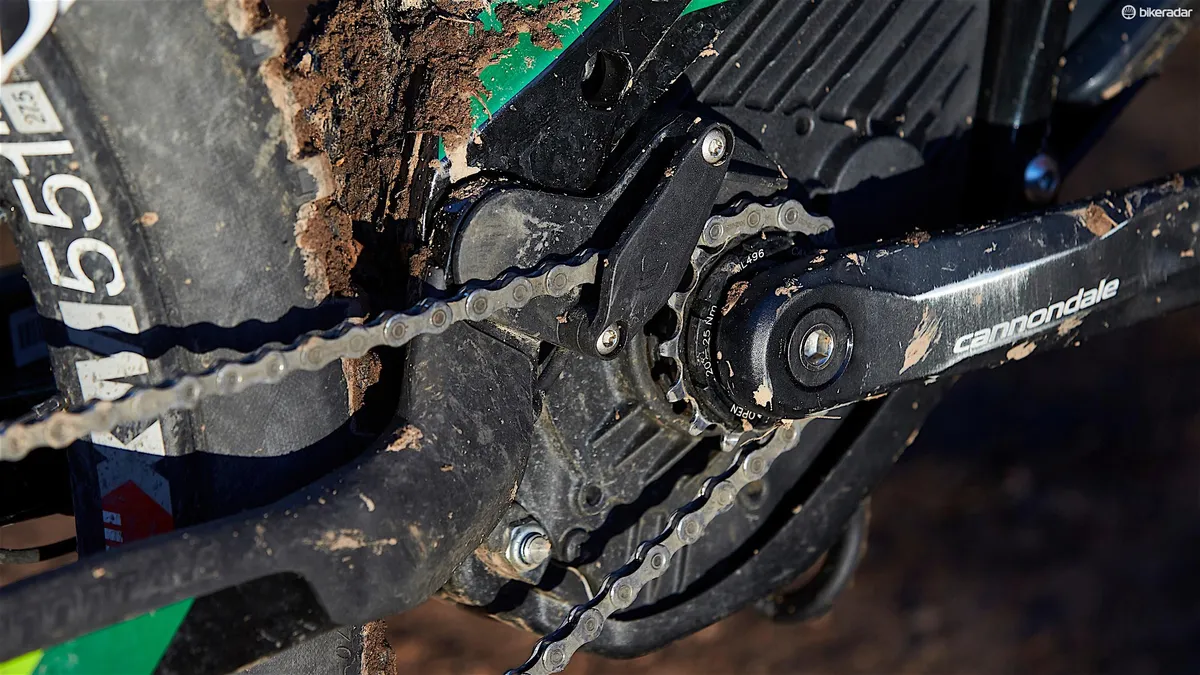
The short chainstays aren’t all down to motor placement though, Cannondale also opted to go with 157mm rear axle spacing, not the more common Boost 148mm spacing we’re used to seeing. This meant it needed to design a custom 6mm offset chainring to maintain correct chainline. There’s also a neatly integrated upper chain guide for added security.But what of this bottle mount, then? The Moterra’s linkage actuated single pivot design with top tube mounted shock combines with the low slung battery placement to provide enough room within the front triangle to fit a bottle cage. There aren't many other e-MTBs that can boast that now, are there.
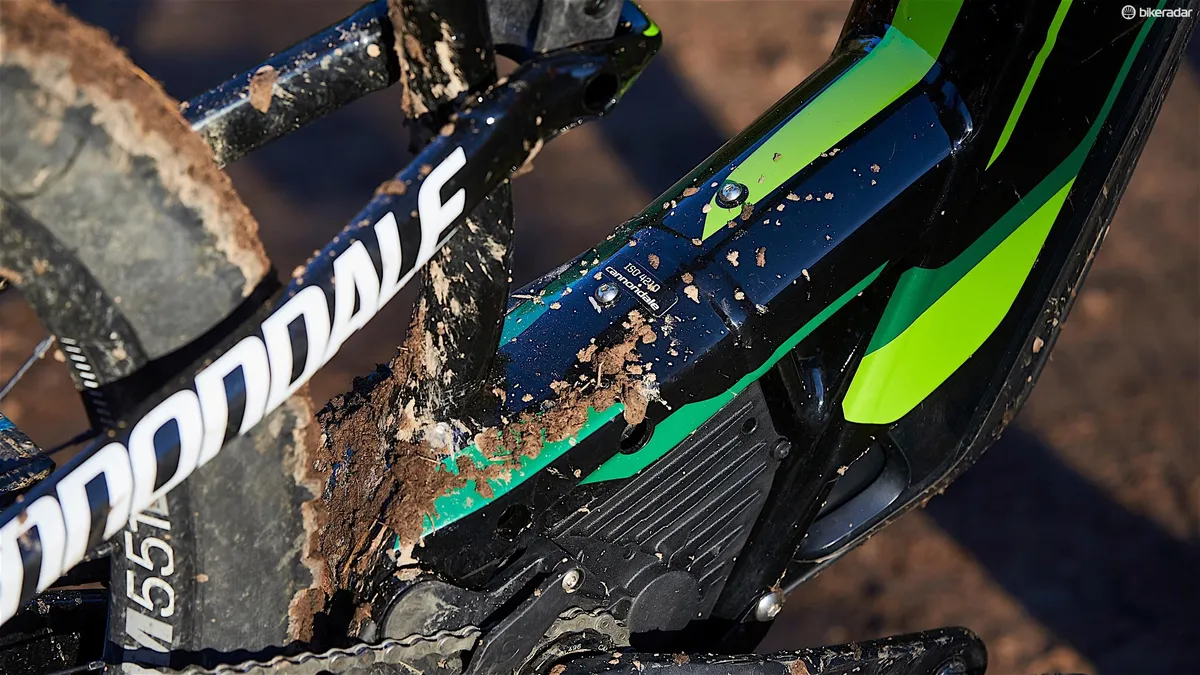
While the Bosch CX Performance 250w motor and chubby, 2.8in Schwalbe Nobby Nic tyres tend to grab the attention, there’s no shortage of neat little touches throughout the Moterra 1. Upfront sits the Fox Float 34 E-Bike Optimised, a 130mm travel fork. This receives a stiffer yet heavier chassis than that of the standard 34. It also gets the FIT 4 damper which allows you to fine tune the low-speed compression in the open mode. Gearing is taken care of by Shimano’s XT 11-speed transmission, complete with an 11-42t cassette. Braking is another Shimano XT affair and throughout these early rides we’ve had no issues with feel or consistency. On rowdier, steeper trails, bigger rotors than the 180mm versions supplied would have been welcome though.
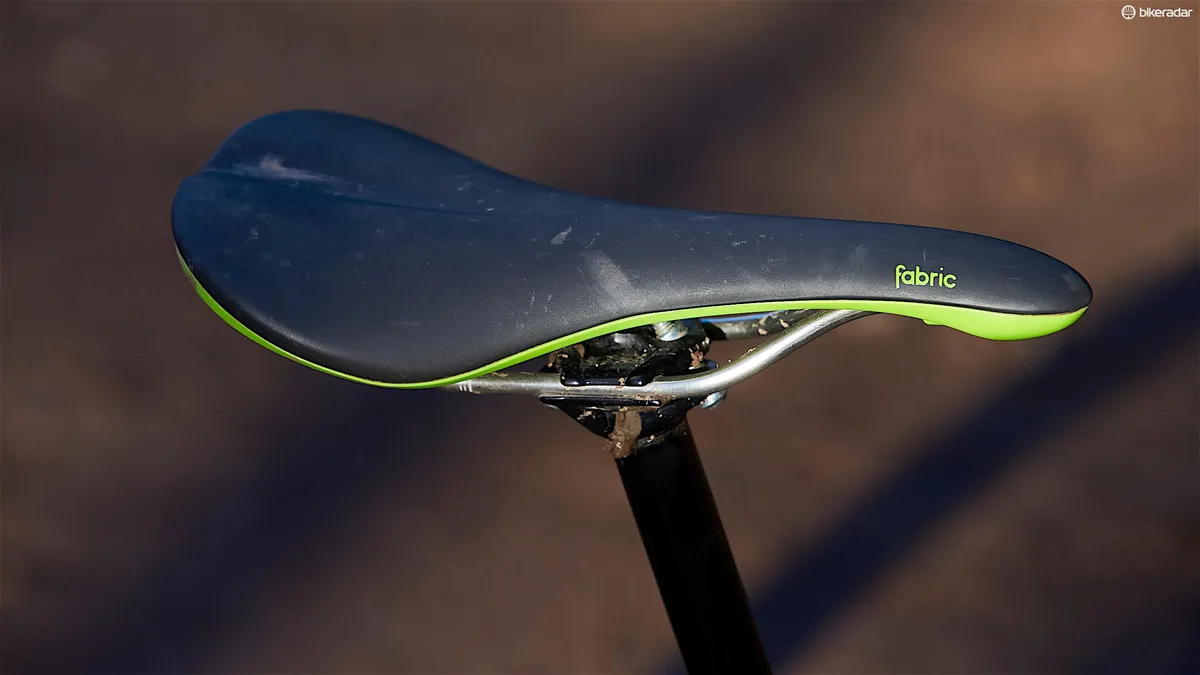
DT Swiss provides its XM551 rims, with a 40mm internal width, which are paired with the Schwalbe rubber — so the tyre profile is nicely rounded. Our only real quibble comes with the thin Nobby Nic tyres, but we’ll come to that in a minute. Finishing is a well-considered affair with Cannondale providing its own 780mm bar and 55mm stem. We’re big fans of the comfortable Fabric Scoop saddle and the KS LEV Integra post (which provides 125mm of drop on the medium, 100mm on the small frame, 150mm on the large/extra-large frames), worked without issue throughout too. All in, the Moterra 1’s not the lightest out there however at 23.15kg (51lb) in size medium.

Aside from Cannondale’s different take on battery placement it has also mounted the motor slightly differently. Its proprietary Si motor mount angles the Bosch Performance CX 250w unit to both align the bike's main pivot with the chain line, in a bid to improve suspension performance, as well as allow the Moterra to sport much shorter chainstays than we’re used to seeing in this category of bike. The 130mm travel AM bike has to accommodate a plus sized 2.8in tyre and has a 457mm chainstay (that’s nearly 20mm shorter than the new Lapierre Overvolt AM with the same Bosch motor), but impressively the 160mm travel LT version that comes shod with regular 2.35in tyres boasts even shorter chainstays at 443mm.

The short chainstays aren’t all down to motor placement though, Cannondale also opted to go with 157mm rear axle spacing, not the more common Boost 148mm spacing we’re used to seeing. This meant it needed to design a custom 6mm offset chainring to maintain correct chainline. There’s also a neatly integrated upper chain guide for added security.But what of this bottle mount, then? The Moterra’s linkage actuated single pivot design with top tube mounted shock combines with the low slung battery placement to provide enough room within the front triangle to fit a bottle cage. There aren't many other e-MTBs that can boast that now, are there.

While the Bosch CX Performance 250w motor and chubby, 2.8in Schwalbe Nobby Nic tyres tend to grab the attention, there’s no shortage of neat little touches throughout the Moterra 1. Upfront sits the Fox Float 34 E-Bike Optimised, a 130mm travel fork. This receives a stiffer yet heavier chassis than that of the standard 34. It also gets the FIT 4 damper which allows you to fine tune the low-speed compression in the open mode. Gearing is taken care of by Shimano’s XT 11-speed transmission, complete with an 11-42t cassette. Braking is another Shimano XT affair and throughout these early rides we’ve had no issues with feel or consistency. On rowdier, steeper trails, bigger rotors than the 180mm versions supplied would have been welcome though.

DT Swiss provides its XM551 rims, with a 40mm internal width, which are paired with the Schwalbe rubber — so the tyre profile is nicely rounded. Our only real quibble comes with the thin Nobby Nic tyres, but we’ll come to that in a minute. Finishing is a well-considered affair with Cannondale providing its own 780mm bar and 55mm stem. We’re big fans of the comfortable Fabric Scoop saddle and the KS LEV Integra post (which provides 125mm of drop on the medium, 100mm on the small frame, 150mm on the large/extra-large frames), worked without issue throughout too. All in, the Moterra 1’s not the lightest out there however at 23.15kg (51lb) in size medium.

Aside from Cannondale’s different take on battery placement it has also mounted the motor slightly differently. Its proprietary Si motor mount angles the Bosch Performance CX 250w unit to both align the bike's main pivot with the chain line, in a bid to improve suspension performance, as well as allow the Moterra to sport much shorter chainstays than we’re used to seeing in this category of bike. The 130mm travel AM bike has to accommodate a plus sized 2.8in tyre and has a 457mm chainstay (that’s nearly 20mm shorter than the new Lapierre Overvolt AM with the same Bosch motor), but impressively the 160mm travel LT version that comes shod with regular 2.35in tyres boasts even shorter chainstays at 443mm.

The short chainstays aren’t all down to motor placement though, Cannondale also opted to go with 157mm rear axle spacing, not the more common Boost 148mm spacing we’re used to seeing. This meant it needed to design a custom 6mm offset chainring to maintain correct chainline. There’s also a neatly integrated upper chain guide for added security.But what of this bottle mount, then? The Moterra’s linkage actuated single pivot design with top tube mounted shock combines with the low slung battery placement to provide enough room within the front triangle to fit a bottle cage. There aren't many other e-MTBs that can boast that now, are there.

While the Bosch CX Performance 250w motor and chubby, 2.8in Schwalbe Nobby Nic tyres tend to grab the attention, there’s no shortage of neat little touches throughout the Moterra 1. Upfront sits the Fox Float 34 E-Bike Optimised, a 130mm travel fork. This receives a stiffer yet heavier chassis than that of the standard 34. It also gets the FIT 4 damper which allows you to fine tune the low-speed compression in the open mode. Gearing is taken care of by Shimano’s XT 11-speed transmission, complete with an 11-42t cassette. Braking is another Shimano XT affair and throughout these early rides we’ve had no issues with feel or consistency. On rowdier, steeper trails, bigger rotors than the 180mm versions supplied would have been welcome though.

DT Swiss provides its XM551 rims, with a 40mm internal width, which are paired with the Schwalbe rubber — so the tyre profile is nicely rounded. Our only real quibble comes with the thin Nobby Nic tyres, but we’ll come to that in a minute. Finishing is a well-considered affair with Cannondale providing its own 780mm bar and 55mm stem. We’re big fans of the comfortable Fabric Scoop saddle and the KS LEV Integra post (which provides 125mm of drop on the medium, 100mm on the small frame, 150mm on the large/extra-large frames), worked without issue throughout too. All in, the Moterra 1’s not the lightest out there however at 23.15kg (51lb) in size medium.

Aside from Cannondale’s different take on battery placement it has also mounted the motor slightly differently. Its proprietary Si motor mount angles the Bosch Performance CX 250w unit to both align the bike's main pivot with the chain line, in a bid to improve suspension performance, as well as allow the Moterra to sport much shorter chainstays than we’re used to seeing in this category of bike. The 130mm travel AM bike has to accommodate a plus sized 2.8in tyre and has a 457mm chainstay (that’s nearly 20mm shorter than the new Lapierre Overvolt AM with the same Bosch motor), but impressively the 160mm travel LT version that comes shod with regular 2.35in tyres boasts even shorter chainstays at 443mm.

The short chainstays aren’t all down to motor placement though, Cannondale also opted to go with 157mm rear axle spacing, not the more common Boost 148mm spacing we’re used to seeing. This meant it needed to design a custom 6mm offset chainring to maintain correct chainline. There’s also a neatly integrated upper chain guide for added security.But what of this bottle mount, then? The Moterra’s linkage actuated single pivot design with top tube mounted shock combines with the low slung battery placement to provide enough room within the front triangle to fit a bottle cage. There aren't many other e-MTBs that can boast that now, are there.

While the Bosch CX Performance 250w motor and chubby, 2.8in Schwalbe Nobby Nic tyres tend to grab the attention, there’s no shortage of neat little touches throughout the Moterra 1. Upfront sits the Fox Float 34 E-Bike Optimised, a 130mm travel fork. This receives a stiffer yet heavier chassis than that of the standard 34. It also gets the FIT 4 damper which allows you to fine tune the low-speed compression in the open mode. Gearing is taken care of by Shimano’s XT 11-speed transmission, complete with an 11-42t cassette. Braking is another Shimano XT affair and throughout these early rides we’ve had no issues with feel or consistency. On rowdier, steeper trails, bigger rotors than the 180mm versions supplied would have been welcome though.

DT Swiss provides its XM551 rims, with a 40mm internal width, which are paired with the Schwalbe rubber — so the tyre profile is nicely rounded. Our only real quibble comes with the thin Nobby Nic tyres, but we’ll come to that in a minute. Finishing is a well-considered affair with Cannondale providing its own 780mm bar and 55mm stem. We’re big fans of the comfortable Fabric Scoop saddle and the KS LEV Integra post (which provides 125mm of drop on the medium, 100mm on the small frame, 150mm on the large/extra-large frames), worked without issue throughout too. All in, the Moterra 1’s not the lightest out there however at 23.15kg (51lb) in size medium.
Cannondale Moterra 1 ride impression
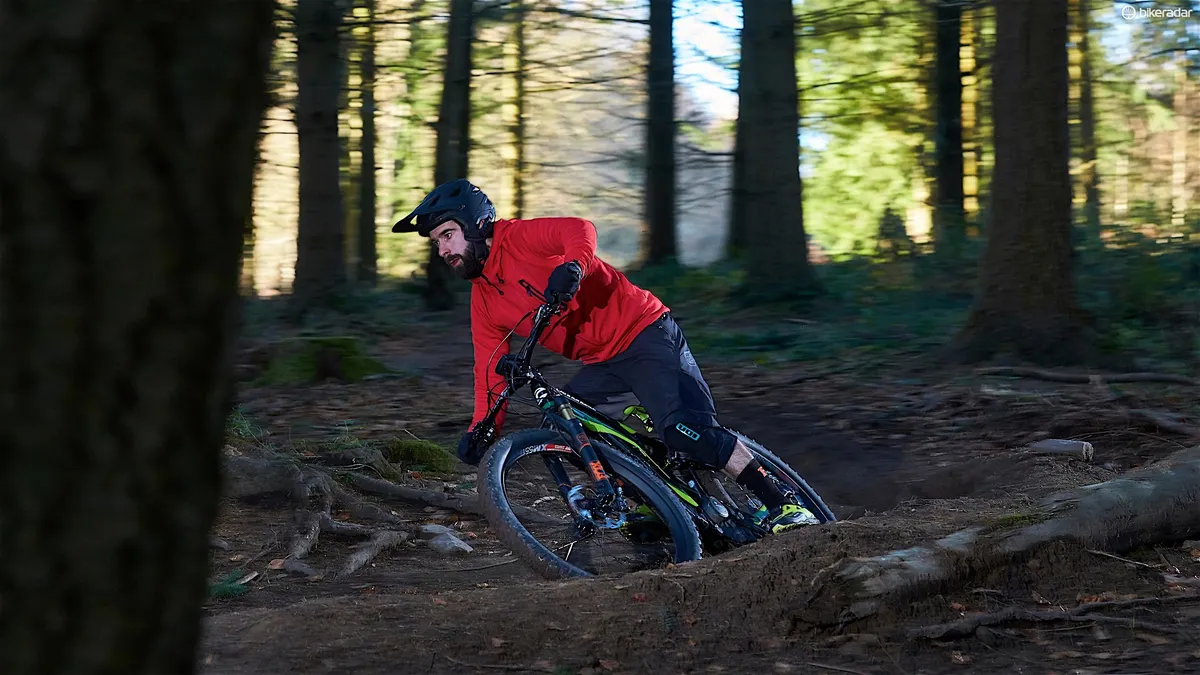
The initial growl of the 2.8in tyres quickly evaporates as soon as the power from the Bosch motor kicks in. The Bosch system has proven time and again that its power delivery is predictable and straight forward to manage, thanks to its Intuvia bar mounted display and easy to reach remote. Sure, it’s not the neatest or most compact, but it does the job just fine. There’s little lag in pick up when the cranks start turning, but setting off on tricky terrain takes some practice, especially if you’re in turbo mode.
It was a pleasant surprise to see just how agile the Moterra can be when threading your way down a technical trail
One of our test loops included some brutal climbs with sections of rock, mud and wet roots covered in greasy mud. What really grabbed our attention early on was just how eager the Moterra was to power up and over these obstacles. Even when the going was seriously loose under tyre, there almost always seemed to be enough traction providing you’re in the right mode and apply power to the cranks smoothly. This is thanks too, in part, to those massive 2.8in tyres — it’s incredible what you can claw your way up. That’s not to say everything about the tyres is positive though. Yes, the bigger tyres certainly add a bit of spring and float into the mix, but push the Moterra hard into steep turns or fast trail section berms and you soon feel them start to squirm.
We started with the pressure we usually run in plus tyres (17psi up front, 18psi at the rear), but with the bike's high weight and, at times, increased speeds, we soon had to increase the pressure as things continued to feel vague at speed and when making quick changes of direction or carving into corners hard. This soon means however that the point of having the extra tyre width is negated.
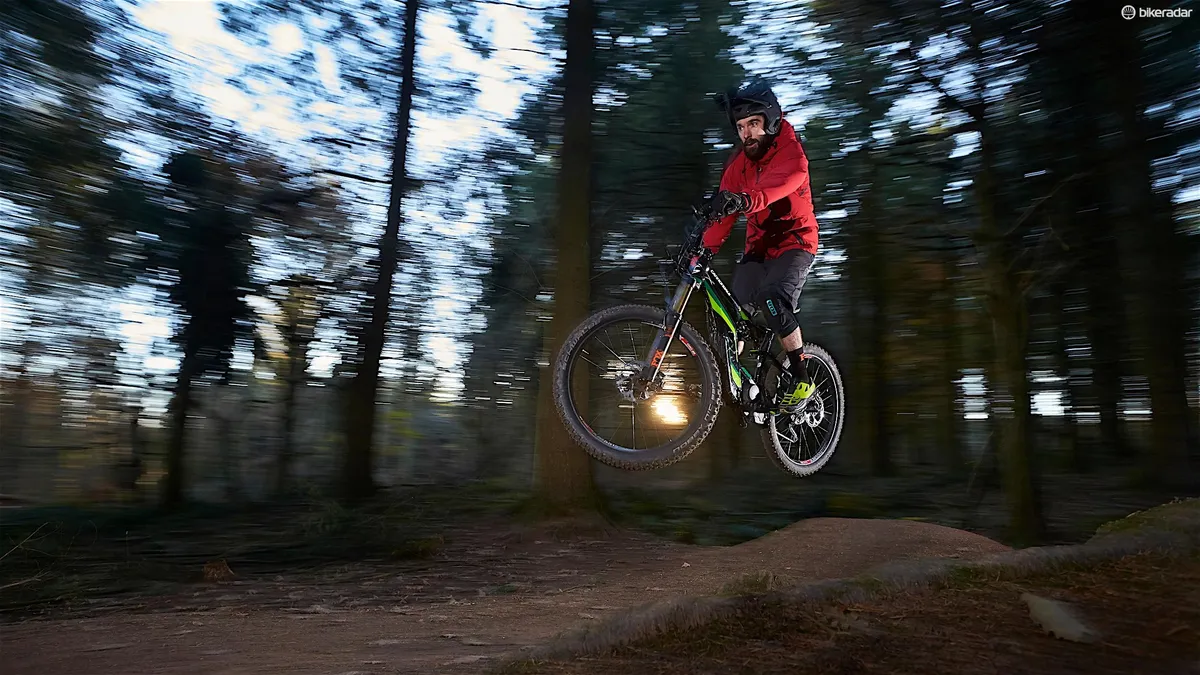
At firmer pressures, we still on occasion had some squirm issues and we can’t help thinking that spec’ing a tyre with a more supportive casing would help here, especially when you consider just how much heavier this bike is compared to a regular plus bike. But if you want to ride really hard, it may be worth checking out the longer travel Moterra LT, which comes with standard width tyres instead — especially if you spend a lot of time riding in the mud.
Still, with tyre related concerns aside for a minute, it was a pleasant surprise to see just how agile the Moterra can be when threading your way down a technical trail. The relatively short back end certainly helps with lofting the front wheel up and over obstacles and we were impressed with how easy and fast changes of direction could be.
The 347mm bottom bracket height meant we had no issues with crank strikes when pedalling in choppy terrain either and coupled with the 19mm drop things didn’t feel too lofty through the turns. We’re keen to try some slightly narrower, lower volume tyres and lower the bottom bracket a little more just to see how this affects cornering prowess, and if it does increase crank strikes when pedalling in rough terrain.
After some time playing with sag and increasing the low speed compression on the 34 fork, the suspension felt balanced enough and stable at speed. Soon enough we were confidently hitting familiar jump trails and some of the steeper downhill tracks where we regularly test longer travel bikes. It was in the steeper stuff where you soon remember you’re riding a 130mm travel bike. That said, we don’t think slackening the 68-degree head angle out a touch would do any harm.
Sizing for our 5ft 8in tester felt just about right on the medium. A decent 612mm effective top tube meant things were comfy enough when seated and even though the 425mm reach isn’t the longest, we still felt comfortable enough when out of the saddle and throwing the Moterra around.
Cannondale Moterra 1 pricing and availability
- 27.5 M Moterra AM 1: £5,199.99 / $N/A / AU$N/A
- 27.5 M Moterra AM 2: £4,299.99 / $5,499.99 / AU$N/A
- 27.5 M Moterra AM 3: £3,799.99 / $N/A / AU$N/A
- 27.5 M Moterra LT 1: £5,499.99 / $N/A / AU$N/A
- 27.5 M Moterra LT 2: £4,499.99 / $N/A / AU$N/A
Cannondale Moterra 1 early verdict
Overall, for general trail riding the Moterra 1 feels agile, relatively playful and lively compared to many other bikes in this category — and pointed uphill it’s a real beast. Yes, some tyres with a more supportive casing would certainly up the corner carving confidence though. As for the motor, we’re big fans of the Bosch unit and, if used cleverly, it’s easy enough to get a good few hours of hard riding in on just the one charge.
